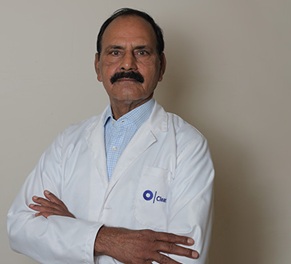Laparoscopic Umbilical Hernia Surgery: Procedure, Recovery
Dr. Aman Priya Khanna

Treatment Duration
30 Minutes
------ To ------45 Minutes
Treatment Cost
₹ 75,000
------ To ------₹ 1,20,000

Table of Contents
- What is Laparoscopic Umbilical Hernia?
- Who needs Laparoscopic Umbilical Hernia Repair?
- Benefits of Laparoscopic Umbilical Hernia Repair
- Protocol Before and On the Day of Laparoscopic Umbilical Hernia Surgery
- Laparoscopic Umbilical Hernia Repair Procedure
- Expectations After Laparoscopic Umbilical Hernia Repair
- Risks and Complications of Laparoscopic Umbilical Hernia Repair
- Risks of Delay in Laparoscopic Umbilical Hernia Repair
- Cost of Laparoscopic Umbilical Hernia Repair
- Takeaway
Opting for laparoscopic hernia surgery to address an umbilical hernia is safe and effective even in cases of multiple prior abdominal surgeries. Patients often favour a less invasive route when dealing with umbilical hernias, drawn to the advantages offered by laparoscopic surgery.
These include minimal incisions and the potential for a speedier recovery process. Read to know more about laparoscopic umbilical hernia surgery, its benefits, procedure, complications and cost.
Procedure Name | Laparoscopic Umbilical Hernia Surgery |
Alternative Name | Laparoscopic Umbilical Hernia Repair |
Conditions Treated | Umbilical hernia |
Benefits of the Procedure | Safe and effective, Minimally invasive, Faster recovery, Shorter hospital stay |
Treated by | General and Laparoscopic Surgeon |
You can check Laparoscopic Umbilical Hernia Repair Cost here.
What is Laparoscopic Umbilical Hernia?
According to the classification by the European Hernia Society, an umbilical hernia [1] is defined as a hernia occurring between 3 cm above and 3 cm below the belly button. It occurs when part of the intestine or abdominal tissue protrudes through a weakened area near the belly button, forming a bulge.
This condition is more prevalent in women and those with elevated intra-abdominal pressure, such as during pregnancy, obesity or ascites. The stretching of the muscles in the abdomen and the presence of fatty tissue make it more likely for muscle bundles to separate. This increases the chances of developing umbilical hernias.
In rare instances, adults with umbilical hernias may get strangulated. It happens when blood flow to the herniated tissue is suddenly blocked. This risk is higher in non-reducible (incarcerated) hernias that cannot be pushed back into the abdominal cavity.
The modern approach to treating umbilical hernias is through laparoscopic surgery, a method replacing the traditional open procedure.
For an efficient and safe solution, laparoscopic umbilical hernia surgery with mesh fixation using absorbable sutures is recommended.

Anatomy and Physiology of Umbilicus
The umbilicus, or belly button, is situated in the centre of the abdomen. It is a remnant of the umbilical cord, which connects a developing baby to the mother's womb during pregnancy.
An umbilical hernia results from the failure of the umbilical ring to close properly. The parts of the belly button consist of the following:
- Nerve Endings: The umbilicus contains nerve endings, making it a sensitive area. Nerves in this area connect to the spinal cord, contributing to the sensation felt when touched.
- Blood Vessels: They transport nutrients from the mother to the baby during pregnancy.
Laparoscopic Umbilical Hernia Repair Videos by HexaHealth
Expert Doctors (10)
NABH Accredited Hospitals (10)
Laparoscopic Umbilical Hernia Repair Success Stories


Who needs Laparoscopic Umbilical Hernia Repair?
Laparoscopic umbilical hernia surgery may be recommended for various reasons to address this condition effectively. The indications are:
- Pain and Discomfort: Persistent pain and discomfort around the hernia site that affects daily activities and quality of life.
- Increasing Hernia Size: Noticeable enlargement of the hernia, indicating a need for surgical intervention to prevent further complications.
- Incarceration of Hernia: The occurrence of incarceration where the hernia becomes trapped and cannot be gently pushed back requires surgery.
- Risk of Strangulation: When a hernia becomes incarcerated, it possesses an increased risk of hernia strangulation. The blood supply is compromised in the nearby areas, necessitating prompt surgery.
- Failed Non-Surgical Management: Ineffectiveness of non-surgical approaches, such as lifestyle modifications or trusses, in managing symptoms or preventing hernia progression.
- Cosmetic Concerns: The appearance of a hernia is causing distress or affecting the self-esteem of a person.

Benefits of Laparoscopic Umbilical Hernia Repair
Laparoscopic surgery offers the advantage of performing other intra-abdominal procedures simultaneously. It streamlines medical interventions and minimises the need for multiple surgeries. The benefits of treating umbilical hernia through laparoscopic surgery are:
- Minimal Invasive: The surgery through laparoscope involves smaller incisions. It results in a more aesthetic outcome with minimal scarring.
- Safe and Effective Technique: The procedure is considered safe and effective, even for individuals with multiple abdominal surgeries.
- Shorter Hospital Stay: It allows for a shorter hospital stay than traditional open surgery. The patient is usually discharged within 2-3 days.
- Quick Recovery: Laparoscopic surgery has a faster recovery than traditional methods. Return to work and daily activities more swiftly.
- Less Pain and Swelling: The patient experiences reduced postoperative pain, swelling, and discomfort. It lowers the risk of complications, leading to a smoother recovery process.

Protocol Before and On the Day of Laparoscopic Umbilical Hernia Surgery
Patients often have questions about what occurs before and on the day of the umbilical hernia surgery. The preparation before the surgery needs to be clarified.
Protocol Before Laparoscopic Umbilical Hernia Surgery
Prior to laparoscopic umbilical hernia surgery, the medical team follows a set of guidelines. It ensures the safety of the patient throughout the process.
On the Day of Laparoscopic Umbilical Hernia Surgery
On the day of laparoscopic umbilical hernia surgery, one can expect the following:
Laparoscopic Umbilical Hernia Repair Procedure
Laparoscopic hernia repair is a minimally invasive surgery performed by a general surgeon. The whole procedure takes about 30-45 minutes. The objective is to repair the hernia by returning the tissue to its proper place and closing the opening of the abdominal wall.
The step-by-step procedure is:
- Patients were positioned supine with arms tucked alongside.
- Monitors were placed on the right side of the bed to check the vitals.
- Following general endotracheal anaesthesia, the abdominal skin was sterilized.
- The surgeon creates two small incisions around the umbilical hernia.
- A laparoscope, a thin tube with a camera, is inserted through one of the incisions.
- The camera provides a view of the abdominal cavity on a video screen.
- The surgeon carefully relocates the bulging tissue back through the abdominal wall hole.
- The mesh was rolled and unrolled inside the abdomen against the abdominal wall to strengthen the area.
- The incision sites are then closed using sutures.

Expectations After Laparoscopic Umbilical Hernia Repair
Adults can generally expect 2 to 4 weeks to recover before resuming normal activities. Children can often return to most activities immediately following surgery.
Recovery in Hospital
Most patients are discharged on the same day for outpatient procedures. Larger hernia repairs may require a short hospital stay, typically not exceeding 2-3 days. The following are done after the surgery:
Vitals Monitoring: Patients are shifted to the recovery room for observation, where vital signs such as pulse, blood pressure, and breathing are closely monitored.
Pain Management: Pain medication is prescribed as needed to manage discomfort.
Dietary Recommendation: Light food like soup is given after the surgery to improve healing.

At-home Recovery
Personalised recovery instructions are tailored to meet your needs after the discharge. At-home recovery after the procedure includes:
- Hernia Compression Belt: After your surgery, the doctor suggests using a hernia compression belt, also known as a truss. It is a wide elastic belt that you wear around your abdomen to provide solid support to your stomach during the recovery period.
It is recommended to wear the belt as often as possible, even while sleeping, for the initial six weeks post-surgery. If necessary, the doctor will guide you on the continued usage. This belt aids in minimizing fluid buildup above the mesh used in the repair process. - Initial Rest Period: Rest immediately after surgery, avoiding other plans on the surgery day. Gradually increase activity from the following day based on your comfort.
- Pain Management Plan: Expect a prescription for pain medication post-surgery. Adhere to the medications as recommended for swift recovery.
- No Fried Food: About a day after surgery, steer clear of fried foods. Opt for easy-to-digest foods like soup, sandwiches, pasta, potatoes, toast, and applesauce.
- Avoid Strenuous Exercise: It is important to avoid more intense activities like running and weight lifting for at least six weeks post-hernia repair to ensure a smooth recovery.

First Follow-up
Follow-up appointments are scheduled after a week to monitor progress and address any concerns. The follow-up will be as follows:
- Surgical Site Examination: The surgeon will inspect the incision site for signs of healing, ensuring proper closure and minimal scarring.
- Symptom Review: Any postoperative symptoms or discomfort will be discussed. This will allow the surgeon to tailor the recovery plan accordingly.
- Activity Guidance: Instructions regarding the gradual resumption of daily activities and exercise may be provided based on the healing progress.
Risks and Complications of Laparoscopic Umbilical Hernia Repair
Laparoscopic umbilical hernia surgery is generally associated with low risks. There can be some rare risks still involved. The risks associated with umbilical hernia repair surgery, including complications during the procedure and the broader risks related to anaesthesia and surgery, are:
Postoperative Complications
Wound Infection: Infection at the surgical site is a potential complication that requires careful postoperative management.
Bleeding: Excessive bleeding may occur if proper care is not taken during the procedure.
Haematoma: There is a risk of the formation of a haematoma. It is a collection of blood outside blood vessels.

Umbilical Hernia-Specific Risks
Intestinal Injury: Though rare, there is a small risk of injury to the small or large intestine during the hernia repair.
Hernia Recurrence: A 2% risk of hernia recurrence during extended follow-up has been found. Medical conditions like ascites and liver cirrhosis are primary factors that can increase the risk of recurrence. Therefore, controlling ascites is necessary before the surgery.
Specific Organ Risks
- Testicular Atrophy: Injury to gonadal vessels may lead to testicular atrophy, emphasizing the need for meticulous surgical care. It is a rare complication with 0.03-0.65% risk.
- Fallopian Tube Damage: In girls, though rare (<1%), there is a possibility of damage to the fallopian tubes during surgery. It can have potential consequences for future fertility.
When to See a Doctor?
If a patient exhibits any alarming signs and symptoms after the surgery, promptly seek medical attention. Recognizing these indicators can help ensure timely intervention. These signs and symptoms can include:
- Fever (101.5 degrees or higher)
- Signs of Infection, such as redness, swelling, or pain
- Any drainage from the incision site
- Persistent pain that is not effectively managed with prescribed pain medicine
- Bulge at the belly button
Risks of Delay in Laparoscopic Umbilical Hernia Repair
Timely medical intervention is needed to address umbilical hernias. Delaying laparoscopic repair may pose risks to one's health. These include:
- Increased Size and Complexity: Delay may increase the size and complexity of the hernia, making the surgical repair more challenging.
- Chronic Pain and Discomfort: The hernia may cause persistent pain and discomfort, affecting the individual's quality of life and daily activities.
- Difficulty in Routine Activity: Delayed repair may contribute to difficulty in performing daily tasks like unable to bend due to the pain in hernia.
- Risk of Incarceration: There is a heightened risk of the hernia becoming incarcerated, where abdominal contents get trapped, potentially causing severe complications.
- Increased Risk of Strangulation: There is an elevated risk of strangulation, where blood flow to the herniated tissue is completely cut off, resulting in tissue death.

Cost of Laparoscopic Umbilical Hernia Repair
The Laparoscopic Umbilical Hernia Repair cost in India can range from ₹ 1,10,000 to ₹ 2,00,000 with an average ₹ 1,40,000. Several factors influence the cost of the procedure, which includes:
- Hospital Facility Costs: The overall cost of laparoscopic umbilical hernia surgery is influenced by the facility where the procedure occurs. Hospitals with advanced technology and high-quality infrastructure may charge more for their services.
- Surgeon's Fee: The expertise and experience of the surgeon performing the laparoscopic hernia surgery can significantly impact the cost. Highly skilled and experienced surgeons may charge higher fees for their services.
- Medical Supplies and Equipment: The use of specialised equipment and disposable supplies during the surgery can contribute to the overall cost. Laparoscopic procedures often involve advanced instruments, which may increase expenses.
- Preoperative Tests and Consultations: Costs may include preoperative tests, such as blood tests and imaging studies, as well as consultations with the surgeon and other healthcare professionals before the surgery.
- Postoperative Care: The recovery process also factors into the overall cost. This includes follow-up appointments, medications, and any additional care needed during the postoperative period.
- Geographic Location: The cost of healthcare services can vary based on geographic location. Urban areas or regions with a higher cost of living may have higher overall expenses for medical procedures.
- Health Insurance Coverage: The extent of health insurance coverage can significantly influence out-of-pocket expenses for the patient. Understanding insurance policies and deductibles is crucial in estimating the personal cost.
- Complications and Unforeseen Circumstances: If complications arise during or after the surgery, additional medical interventions may be required, potentially increasing the overall cost. Unforeseen circumstances can contribute to unpredicted expenses.
Procedure | Cost |
Laparoscopy Umbilical Hernia Repair | ₹ 1,10,000 to ₹ 2,00,000 |
Takeaway
Laparoscopic surgery is becoming popular for hernia treatment, particularly for recurrent hernias. It results in minimal scarring and swift recovery.
Schedule a free online consultation with HexaHealth for laparoscopic umbilical hernia surgery. You can discuss your condition, including the benefits and considerations of laparoscopic surgery, with one of our top healthcare providers.
Suggested Reads
| Precautions after Hernia Surgery |
Ways to Prevent Hernia |
| Inguinal Hernia Surgery |
Laparoscopic Inguinal Hernia Repair |
| Ventral Hernia Surgery |
Laparoscopic Hernia Surgery |
Frequently Asked Questions (FAQ)
What is laparoscopic umbilical hernia surgery?
Laparoscopic umbilical hernia surgery is a minimally invasive procedure where small incisions are made near the belly button. A thin, flexible tube with a camera is inserted to repair a hernia in the abdominal wall.
Why is laparoscopic surgery recommended for umbilical hernia repair?
Laparoscopic surgery is often recommended for umbilical hernia because it involves smaller incisions. It leads to less pain and a quicker recovery for the patient. This, in turn, allows the patient to return to normal activities faster than in open surgery.
How is laparoscopic umbilical hernia surgery different from traditional open surgery?
Laparoscopic umbilical hernia surgery involves making small incisions and using a camera to repair the hernia. It results in less pain and a faster recovery. In contrast, traditional open surgery requires a larger incision, potentially leading to more discomfort and a longer recovery time.
What are the indications for undergoing laparoscopic umbilical hernia surgery?
Laparoscopic umbilical hernia surgery may be recommended if the hernia is bigger and causes symptoms such as pain or discomfort. In some cases, a patient may choose laparoscopic surgery for quicker recovery and less postoperative pain.
How should I prepare for laparoscopic umbilical hernia surgery?
Before surgery, the surgeon might advise stopping certain medications. Inform them about all medications, including supplements. Follow the surgeon's instructions regarding fasting.
What is the typical recovery time after laparoscopic umbilical hernia surgery?
Recovery time varies between individuals after laparoscopic umbilical hernia surgery. Typically, there's a lifting restriction of 5-10 kgs for 4-6 weeks. The return to work depends on job demands, with desk-type work often resuming in 1-2 weeks.
Are there any restrictions or precautions to follow post-surgery?
After surgery, adhere to lifting restrictions (usually 5-10 kgs) for 4-6 weeks and gradually resume activities as advised by the surgeon. It's crucial to follow postoperative guidelines to ensure a smooth recovery.
What are the potential risks and complications of laparoscopic umbilical hernia surgery?
Complications after laparoscopic umbilical hernia surgery are uncommon. The rare complications include:
Infection at the surgical site
Seroma formation
Bleeding
Recurrence of hernia
How common are complications, and what measures are taken to prevent them?
Umbilical hernia surgeries usually have rare complications after the surgery, like minor infections and bleeding. In the long term, there's a 2% chance of the hernia returning. Surgeons take precautions like sterile techniques and careful monitoring during and after surgery to minimize potential risks.
What is the cost of laparoscopic umbilical hernia surgery?
Umbilical hernia laparoscopic surgery cost ranges from ₹ 1,10,000 to ₹ 2,00,000 with average ₹ 1,40,000. It can depend on several factors like hospital facility, consultation fees, surgeon’s experience, etc.
How does the cost of laparoscopic surgery compare to traditional open surgery?
Below is the table to compare the umbilical hernia surgery cost for open and laparoscopic procedure
Procedure | Maximum Cost | Minimum Cost | Average Cost |
Open Umbilical Hernia Surgery | ₹ 80,000 | ₹ 1,50,000 | ₹ 1,10,000 |
Laparoscopic Umbilical Hernia Surgery | ₹ 1,10,000 | ₹ 2,00,000 | ₹ 1,40,000 |
Does insurance typically cover the cost of laparoscopic umbilical hernia surgery?
Yes, insurance covers the cost of laparoscopic umbilical hernia surgery, depending on the insurance plan. It's advisable to check with the insurance provider to understand coverage details and potential out-of-pocket expenses.
How do I choose a qualified surgeon for laparoscopic umbilical hernia surgery?
Select a qualified surgeon for laparoscopic umbilical hernia surgery by checking their credentials, experience, and board certification. Ask for recommendations from your primary care doctor or friends, and ensure the surgeon is affiliated with a reputable medical institution.
What diagnostic tests are conducted before laparoscopic umbilical hernia surgery?
A skilled surgeon examines the hernia during a physical check-up. He may recommend the following diagnostic tests before the surgery:
Routine tests like blood work and an EKG may be done based on age and existing health conditions.
Additionally, an ultrasound or a CT scan may be advised for a closer look.
Are there any specific lifestyle changes or medications to consider before surgery?
Consult your surgeon before considering any routine changes. Below are a few changes that a doctor may recommend:
Before hernia surgery, talk to your surgeon about all medications, including supplements.
Follow lifestyle recommendations from your surgeon, such as adjustments to diet, to ensure the best possible condition before the procedure.
If you smoke, quitting before surgery can aid in better healing and reduce complications.
Maintaining a healthy weight may contribute to a smoother recovery.
How is laparoscopic umbilical hernia surgery performed step-by-step?
The step-by-step procedure of laparoscopic umbilical hernia surgery is as follows:
- General anaesthesia is administered after the patient is positioned.
- The surgeon makes small incisions as it is a minimally invasive surgery.
- A thin and flexible instrument called a laparoscope, with a camera, is inserted to visualize the hernia area on a screen.
- The main aim of the surgery is to carefully push the bulging tissue back into place and stitch the abdominal wall.
- A synthetic mesh is inserted into the abdomen to strengthen the area and prevent recurrence.
Are there follow-up appointments after laparoscopic umbilical hernia surgery?
Yes, a follow-up appointment after a laparoscopic umbilical hernia surgery is there. It monitors healing, addresses potential complications, and ensures the patient's overall recovery.
Will there be any long-term effects or changes after laparoscopic umbilical hernia surgery?
Long-term effects after laparoscopic umbilical hernia surgery are minimal, with low recurrence rates and high patient satisfaction. Most individuals experience improved abdominal strength and function.
Are there non-surgical alternatives for managing umbilical hernias?
Non-surgical alternatives for managing umbilical hernias include using supportive garments or trusses. It may provide symptomatic relief but does not address the underlying hernia. These measures may temporarily alleviate discomfort, but surgical repair remains the primary treatment of hernia.
Are there any dietary or exercise restrictions post-surgery?
Following laparoscopic umbilical hernia surgery, patients may not have strict dietary restrictions. It is advisable to gradually resume normal eating patterns while avoiding heavy lifting or strenuous exercises for at least six weeks.
Can pregnant women undergo laparoscopic umbilical hernia surgery?
Pregnant women can undergo laparoscopic umbilical hernia surgery. However, it is generally recommended to postpone until after delivery due to potential risks.
References
All the articles on HexaHealth are supported by verified medically-recognized sources such as; peer-reviewed academic research papers, research institutions, and medical journals. Our medical reviewers also check references of the articles to prioritize accuracy and relevance. Refer to our detailed editorial policy for more information.
- Gonzalez R, Mason E, Duncan T, Wilson R, Ramshaw BJ. Laparoscopic versus open umbilical hernia repair. JSLS. 2003 Oct-Dec;7(4):323-8. PMID: 14626398; PMCID: PMC3021337.

- Kulaçoğlu H. Current options in umbilical hernia repair in adult patients. Ulus Cerrahi Derg. 2015 Sep 1;31(3):157-61. doi: 10.5152/UCD.2015.2955. PMID: 26504420; PMCID: PMC4605112.

- Umbilical hernia repair. nhs.uk. [cited 2023 Nov 15]

- Umbilical hernia repair - How it’s performed. nhs.uk. [cited 2023 Nov 15].

- Troullioud Lucas AG, Jaafar S, Mendez MD. Pediatric Umbilical Hernia. StatPearls Publishing; 2023.

- Almaimani G, Oyais A. Laparoscopic umbilical hernia repair using a Two-port technique: A single-centre experience. Journal of Current Surgery [Internet]. 2017 [cited 2023 Nov 15];7(3):39–41.

- Albanese CT, Rengal S, Bermudez D. A novel laparoscopic technique for the repair of pediatric umbilical and epigastric hernias. J Pediatr Surg. 2006 Apr;41(4):859-62. doi: 10.1016/j.jpedsurg.2005.12.033. PMID: 16567211

- Umbilical hernia repair. Medlineplus.gov. [cited 2023 Nov 15].

- Umbilical hernia - repair & surgery. Mount Sinai Health System. [cited 2023 Nov 15].

- Abhishek V, Mallikarjuna MN, Shivaswamy BS. Laparoscopic umbilical hernia repair: Technique paper. ISRN Minim Invasive Surg. 2012 [cited 2023 Nov 15];2012:1–4.

- Wright BE, Beckerman J, Cohen M, Cumming JK, Rodriguez JL. Is laparoscopic umbilical hernia repair with mesh a reasonable alternative to conventional repair? Am J Surg. 2002;184(6):505–8

- Americanjournalofsurgery.com. [cited 2023 Nov 15].

Last Updated on: 27 February 2024
Reviewer

Dr. Aman Priya Khanna
MBBS, DNB General Surgery, Fellowship in Minimal Access Surgery, FIAGES
14 Years Experience
Dr Aman Priya Khanna is a well-known General Surgeon, Proctologist and Bariatric Surgeon currently associated with HealthFort Clinic, Health First Multispecialty Clinic in Delhi. He has 14 years of experience in General Surgery, Proctolo...View More
Author

She has extensive experience in content and regulatory writing with reputed organisations like Sun Pharmaceuticals and Innodata. Skilled in SEO and passionate about creating informative and engaging medical conten...View More
Laparoscopic Umbilical Hernia Repair Cost in Top Cities
Latest Health Articles



































